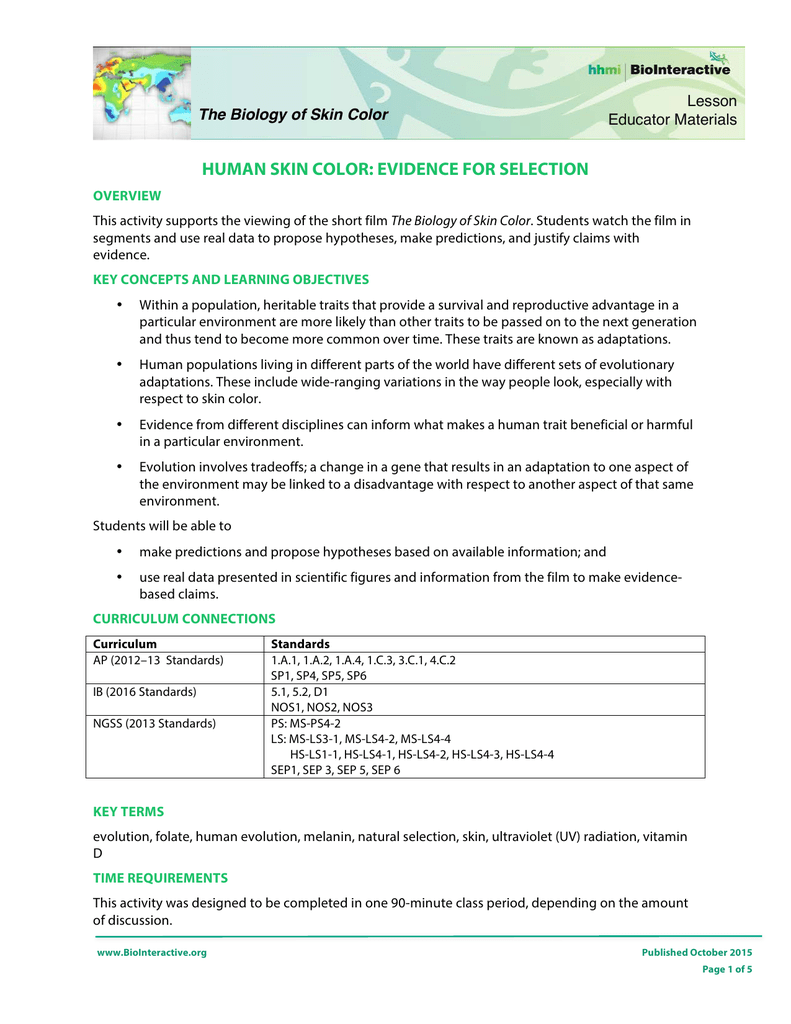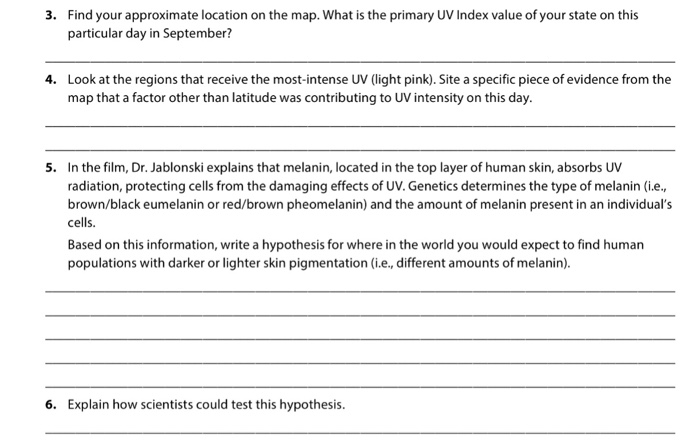Human Skin Color Evidence for Selection Answers
This delicate balancing act explains why the peoples that migrated to colder geographic zones with less sunlight developed lighter skin color. Human populations living in areas of intense sunlight tend to be darker skinned because of the increases UV light.

Human Skin Color Evidence For Selection
These markers link the members of a haplogroup back to the markers first appearance in the groups most recent common ancestor.

. The answer to why skin color is different for different individuals lies within your DNA. Evidence for Selection INTRODUCTION. Describe the predicted effects of using a tanning booth which exposes skin to UV light on the blood levels of these two vitamins 22.
Many biological traits have been shaped by natural selection. Skin colour is linked to evolutionary fitness through the amount of melanin an individual has. Many biological traits have been shaped by natural selection.
As people moved to areas farther from the equator with lower UV levels natural selection favored lighter skin which allowed UV rays to penetrate and produce essential vitamin D. Skin color from pinkish white to dark brown evolved throughout human history. Thus populations found in equatorial areas will have the darkest skin most eumelanin and populations at higher latitudes will have lighter skin least eumelanin.
EVIDENCE FOR SELECTION INTRODUCTION Our closest primate relatives have pale skin under dark fur but human skin comes in a variety of shades from pinkish white to dark brown. EVIDENCE FOR SELECTION INTRODUCTION Our closest primate relatives have pale skin under dark fur but human skin comes in a variety of shades from pinkish white to dark brown. Darker skin protects circulating folate from being broken down.
In the early 1990s the evolution of skin color was regarded by many of her peers as an intractable problem. Based on what you know about skin pigmentation so far suggest a mechanism by which UV intensity could provide a selective pressure on the evolution of human skin color. Evidence for Selection INTRODUCTION Our closest primate relatives have pale skin under dark fur but human skin comes in a variety of shades from pinkish white to dark brown.
In other words propose a hypothesis that links skin color to evolutionary fitness. Biology questions and answers. Evidence for Selection OVERVIEW This activity supports the viewing of the short film The Biology of Skin ColorStudents watch the film in segments and use real data to propose hypotheses make predictions and justify claims with evidence.
Many biological traits have been shaped by natural selection. A light skin tone would be expected to be correlated with higher levels of folate because the darker you are the UV rays deplete the folate levels. Learn vocabulary terms and more with flashcards games and other study tools.
How did this variation arise. How did this variation arise. Our closest primate relatives have pale skin under dark fur but human skin comes in a variety of shades from pinkish white to dark brown.
Explanation for why humans living in different parts of the world have different natural skin colors. Human Ewolution Red 2018 Mhmi Biointeractive Activity Human Skin Color. Many biological traits have been shaped by natural selection.
They are defined by genetic mutations or markers found in molecular testing of chromosomes and mtDNA. At specific pause points students analyze data presented in a scientific figure and interpret graphs to make evidence-based claims using the. Of course creationists agree that differences in human skin color can be traced back to the process of natural selection.
KEY CONCEPTS Within a population. Vitamin D and folate levels in the blood are both affected by UV light. How did this variation arise.
Darker skin colors evolved because they provided increased fitness in early human populations living in equatorial Africa. Theory held that darker skin had evolved in order to afford early humanswho had recently lost the cover of fura protection against skin cancer under the tropical sun. Haplogroups often have a geographic relation.
Evidence for Selection Student Handout 21. Some hu man populations migrated out of Africa to places where UV radiation was less intense. In this case study students use real data to propose hypotheses make predictions and justify claims with evidence as an exploration of concepts presented in the short film The Biology of Skin Color.
Helen Snodgrass describes how she uses the Biology of Skin Color film and the Evidence for Selection activity to show students how humans have evolved over t. How did this variation arise. After humans were dispersed from the Tower of Babel the emigrating populations would have encountered vastly different environments.
Then they look for. A synthesis of mtDNA studies concluded that an early exodus out of. Specifically students learn how patterns in variation for the MC1R gene provide evidence that dark skin is favored in environments that experience intense UV radiation.
As mentioned briefly in the film however human skin color. To determine whether the variation in human skin color is the. Most people are familiar with the DNA that is found within the nucleus of a cell but by tracing mitochondrial DNA mtDNA lines scientists have been able to figure out when the human ancestors began moving out of Africa into different climates.
Human Evolution Revised April 2018 Page 1 of 4 Activity Educator Materials Human Skin Color. Biology questions and answers. EVIDENCE FOR SELECTION INTRODUCTION Our closest primate relatives have pale skin under dark fur but human skin comes in a variety of shades from pinkish white to dark brown.
Start studying Human Skin Color. HUMAN SKIN COLOR. To determine whether the variation in human skin color is the result of evolution by natural selection scientists look for patterns revealing an association between different versions of the trait and the environment.
Answers will vary but students may predict that populations with darker skin color or more eumelanin would be found in regions with more intense UV radiation. How did this variation arise. Many biological traits have been shaped by natural selection.

Solved Human Skin Color Evidence For Selection Introduction Chegg Com

Solved Human Skin Color Evidence For Selection Introduction Chegg Com

Solved Human Skin Color Evidence For Selection Introduction Chegg Com
Human Skin Color Evidence For Selection Lesson Plan For 10th 12th Grade Lesson Planet
Comments
Post a Comment